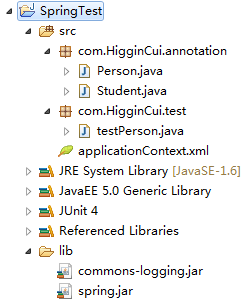09_注解01
【工程截图】

【Student.java】
package com.HigginCui.annotation;
public class Student { public void sayHello(){ System.out.println("Student say: hello!!"); } }
【Person.java】
package com.HigginCui.annotation; import javax.annotation.Resource; public class Person { @Resource(name="student") private Student student; public void sayHello(){ this.student.sayHello(); } }
【applicationContext.xml】
<?xml version= "1.0" encoding ="UTF-8"?> <beans xmlns="http://www.springframework.org/schema/beans" xmlns:context="http://www.springframework.org/schema/context" xmlns:xsi="http://www.w3.org/2001/XMLSchema-instance" xsi:schemaLocation="http://www.springframework.org/schema/beans http://www.springframework.org/schema/beans/spring-beans-2.5.xsd http://www.springframework.org/schema/context http://www.springframework.org/schema/context/spring-context-2.5.xsd"> <!-- 把person和student都放入spring容器 --> <bean id="person" class="com.HigginCui.annotation.Person"></bean> <bean id="student" class="com.HigginCui.annotation.Student"></bean> <!-- 启动依赖注入的注解解析器 --> <context:annotation-config></context:annotation-config> </beans>
【testPerson.java】
package com.HigginCui.test; import org.junit.Test; import org.springframework.context.ApplicationContext; import org.springframework.context.support.ClassPathXmlApplicationContext; import com.HigginCui.annotation.Person; public class testPerson { @Test public void test(){ ApplicationContext context=new ClassPathXmlApplicationContext("applicationContext.xml"); Person person=(Person) context.getBean("person"); person.sayHello(); } }
【运行结果】
Student say: hello!!
【小结】
执行顺序:
1.启动Spring容器
2.Spring容器内部创建了两个对象:porson和student
3.当Spring容器中解析到<context:annotation-config></context:annotation-config>时,启动依赖注入的注解解析器。
4.Spring容器在容器中查找所有的bean(此时有person,student)
5.如果属性上面有该注解(例如:@Resource(name="studnet")),再次检查是否有name属性
6.如果没有name属性,则会把该注解标注的属性的名称获取到并且和Spring容器中的id做匹配,如果匹配成功,则赋值。如果匹配不成功,再按照类型进行再次匹配,匹配成功,再赋值。若还是匹配不成功,则报错。
7.如果有name属性(例如@Resource(name="studnet")),则把name属性的值解析出来和Spring容器中的id做匹配,如果匹配成功,则赋值,不成功则报错。
8.上述的步骤看出注解的效率较低,Xml的效率较高。注解编写较简单,而Xml的书写较复杂。
关于Spring容器中的DI注解
1.按照类型进行匹配
@Autowired
2.按照id进行匹配
@Qualifier("student")





 浙公网安备 33010602011771号
浙公网安备 33010602011771号